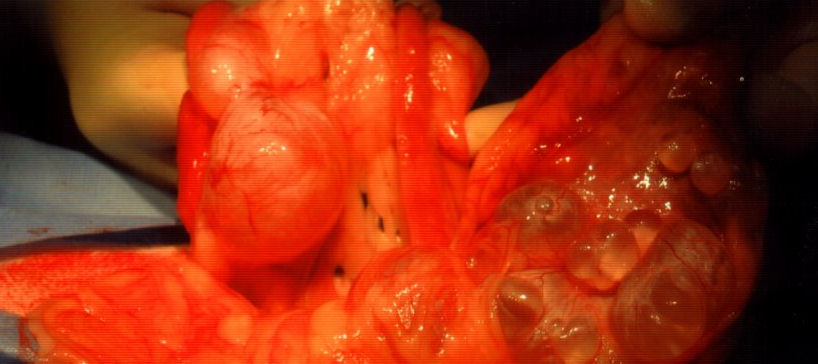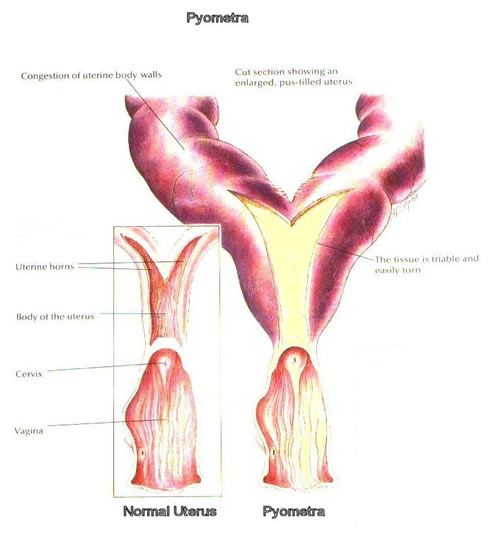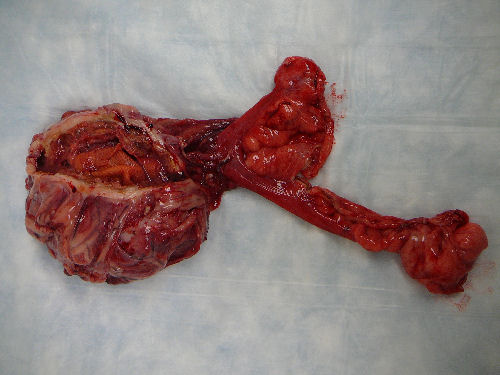 Pyometra Kills
Pyometra Kills
This article is dedicated to Nova and Star. Nova, who we thought was expecting puppies but came down with pyometra - a very dangerous and life threatening infection intact bitches can get. And Star, who was ruling the pack with an iron paw one minute, and two hours later was fighting for her life. It's not known how it's transmitted, only that it's very dangerous. The uterus fills with pus and becomes huge and toxic. Both recovered from "pyo" only to tragically die 3 weeks later from infection left behind.
I have added information to the site about Pyometra as it's something anyone with an intact girl should know more about. Spaying prevents the danger completely. Even though we were aware of the symptoms, we didn't see it coming because the symptoms are not easily noticed, especially if you are expecting pregnancy. They are easy to miss until it's advanced and dangerous. We've had 3 experiences with this scary infection - two naturally caused, one caused by a veterinarian's mistake! Unfortunately, even with excellent care we didn't expect them to die a month later from complications. Nova and Star had both made a complete recovery after being spayed, or so we thought. But with any surgery comes the risk of blood clots, and suddenly without warning, we lost Nova.
With Star it was the complication of meningitis - the infection went into her spinal cord. Mula survived her fate - mainly because we knew what to look for and Michigan State Veterinary Hospital had a crack Pyometra vet on duty that day. Mula's should have never happened - it was caused by a piece of gauze left behind during a c-section that caused the pyometra infection. Thanks to all our puppy owner friends, the friends we've made from this website, and everyone who has helped us through this awful trying period.
SYMTOMS EASILY MISSED:
-
temperature
-
thirst
-
weakness
-
sometimes discharge
-
high white cell counts
-
sometimes all you get is a lethargic dog that doesn't want to do anything (Star and Mula)
About Pyometra...
Pyometra is a life threatening emergency. It is caused by infection. Perhaps you've bred your girl...everything looks good. She seems tired, is drinking a fair amount of water and her belly is getting larger - she seems pregnant. Or you didn't breed her and it's about a month since her last season.... Suddenly she seems more lethargic and walks carefully, so you attribute it to just being pregnant or moodiness - but then she gets picky and finally refuses to eat. If lucky, you may see a foul discharge from her vagina. You take her to the vet for an ultrasound and lo and behold - she's not pregnant or moody after all - she has Closed Cervix Pyometra! A life threatening and dangerous infection of the uterus. You have two options - spay (dangerous and 5-10 times more expensive due to the risk) or Prostaglandin therapy (extremely risky and dangerous, painful and miserable for the bitch and expensive as well). Unfortunately, sometimes your decision is made for you before you can decide what to do and she dies before you get her to the vet.
Or...you return home to find her weak and almost to collapse. She was fine a couple of hours earlier so you wait a bit to see if it's something passing. It's not, so you rush her to the emergency vet with no symptoms other than you know something is wrong and she's not acting "normal". She's weak and lethargic, but unless they do an ultrasound, it's difficult to tell she is even sick except that you know something is wrong.
Or...suddenly the happy-go-lucky dog that would never say "no" to playing outside just wants to lie in her bathroom and do nothing...

This is a uterus that pyo-ed that was filled with cysts. This is Star's uterus...while we aren't sure what caused the pyometra in this case, there were many cysts throughout the horns which may have contributed to infection or rupture. The color is more "orange" signifying disease of some sort (whether caused by the infection or the cysts is unknown).
Pyometra is an infection of the uterus which usually occurs 2 to 6 weeks after a heat (estrus) cycle. Because during estrus, the cervix is open to allow conception, some of the body's natural defenses are relaxed allowing infection to enter the uterus from the the vagina. The cervix then often closes down again allowing the the uterus to fill with infectious material or "pus". Pets may exhibit a variety of symptoms, the most common being lethargy, loss of appetite and increased water intake and urination. If the cervix is open, there may be a heavy purulent (pus) vaginal discharge. But often nothing is discharged, so there are no VISABLE symptoms other than the dog's personality change.
There are two kinds of Pyometra:
1) Open Pyometra: This is easier to detect because there is a purulent discharge, lethargy, fever, anorexia, and sometimes vomiting.
2) Closed Cervix Pyometra: This more sinister and deadly because there is no discharge but the other signs and symptoms are present. The infection remains within the body and diagnosis is difficult because nothing shows externally. Blood work, radiology, ultrasound and physical examination are used to rule out other causes before a definite diagnosis of Closed Cervix Pyometra can be made. With ultrasound, sometimes fluid can actually be seen in the horns of the uterus and white cell counts may be high, leading to the diagnosis.
Both kinds of Pyometra are life-threatening so an ovariohysterectomy is recommended by most veterinarians because even if treated medically with prostaglandins, it will almost always recur. The uterus may be hundreds of times normal size, sometimes exceeding that of a pregnancy. The wall of the uterus can also become very thin and susceptible to rupture. Left untreated, Pyometra is a fatal condition. It's a particularly painful way to die. If you suspect it, GET YOUR GIRL TO A VET IMMEDIATELY. Surgery (usually a spay) and concurrent treatment (flush out the body cavity with saline - Mula had a scar from her ribs to her pubic area) is extremely costly. For a valuable brood bitch or one at the height of a show career there is the option of hormone treatment to expel the pus from the uterus and treat with strong antibiotics. Unfortunately the treatment is very hard and dangerous and often doesn't work. It's like being hard labor for a couple of weeks. In the course of treatment prostaglandins are given causing the uterus to, in a sense, go into labor to push out the infected pus. There is risk the uterus could rupture, or that the infection could be pushed out through the fallopian tubes into the body cavity causing perionditis. Treatment with prostaglandins has proved to be successful in a majority of cases of open cervix Pyometra, but unsuccessful in almost all closed cervix cases. If the uterus ruptures, there are no options except spay, antibiotics and supportive care.

The large grapefruit sized thing is what grew around the piece of surgical gauze left in Mula which caused the pyometra-like symptoms. It is not there in a normal uterus, but is the body's way of isolating a foreign body and trying to isolate infection. That worked for 8 months - until it grew too large. The 2 horns of the uterus are visable and red - healthy tissue that had to be removed due to the growth being at the entrance of the uterus and the septic condition of the cavity. Because the gauze was left on the outside of the uterus, infection was in the abdomen rather than in the uterine horns as it normally would be in a true pyometra. While it was not true pyometra, it was caused by infection so is classified as a "vet induced pyometra". The symptoms she exhibited were the same as classical pyometra and it affected the same body parts.

If treated with prostaglandins, she should be bred at the next heat in order to forestall another episode of Pyometra. I've heard the possibility that it is almost a 50/50 chance of it recurring at the next heat. Treatment with prostaglandins in closed cervix Pyometra is very risky and much less likely to be effective. Spaying is really the safest means of saving her life. We've had 2 girls die, even though they were spayed, so take this VERY VERY seriously! Mula was only saved because MSU took extraordinary measures to flush out her abdomen properly and put her on massive doses of IV antibiotics. She had a 1 1/2 ft incision the entire length of her abdomen and was hospitalized for several days. I am not sure how the infection being outside the uterus (vs. inside it as in a real pyo) affected the outcome (her living).
There is no evidence to support the notion that bitches who experience oestrous cycle anomalies or pseudopregnancies are more at risk of developing Pyometra. It is not caused by an artificial insemination breeding or natural breeding since an unbred bitch can get it as well. It is more likely as the bitch gets older. During estrus the interior wall of the vagina is devoid of white blood cells protect against infection because they would kill the sperm. Introduction of bacteria by almost any means can take hold and cause infection.
Unless too much time has passed and the dog has become too sick to withstand the surgery, most dogs will make a complete recovery following Pyometra surgery. This has not been our experience because In our case we had complications to the pyometra. Be sure your vet gives STRONG antibiotics, even if she is spayed. In Nova's case, we strongly suspect the infection went to her heart. She died almost instantly in our arms with no time to even rush her to the vet. With Star we knew what to look for, but again, 3 different vets missed important signs. The pyometra went into her spine and she developed spinal meningitis - which can look like a lot of other problems to the untrained eye. One vet diagnosed glaucoma, another saw meningitis, but didn't do a spinal tap to prescribe the RIGHT antibiotic, another prescribed a steroid which masks symptoms - by the time we found a neurologist that knew what to do we had lost precious time. Star died of seizures from the meningitis caused by leftover pyometra infection.
Not just a "big dog" problem. Even tiny dogs can get it...this story is shared with permission...
Dixie was the healthiest one we've ever had until she got sick. At 5 1/2 years old she had never had a loose stool and had never thrown up the first time. That's a first because as you know puppies throw up and they have loose stools. Not Dixie.
On a Tuesday six weeks ago she had her first loose stool, and I took note of it, but not to the point of worrying. The next day she was a little lethargic, but seemed better. By that night, however, she was not eating, but we were still not alarmed until late that night, when we decided to take her to the Vet the next day if she did not improve.
Dixie slept on the pillow at our heads and she throw up on it that Thursday morning. I took her out, however, and she did her business and seemed chipper. So I thought she was getting better. But that afternoon she took a dive and we rushed her to an emergency hospital where they informed us of the problem.
We had had an older dog come down with pyometra about seven years ago, and we went through hell and a huge expense with her, but she lived through it and lived five more years. So we knew we were in for trouble, but quite honestly we were in shock!
Dixie made it through the operation and was recovering. Sunday evening she stood up for the first time and walked across the table to us—wagging her tail, just as she did every time she saw my wife and me. The several doctors and orderlies came in the room and were celebrating and so were we. We called our friends and one was planning a party in Dixie's name, because they said we could pick her up the next day.
Her main doctor got off Monday morning and called us before she left and said, She's just fine. She's doing really wonderful. You can pick her up this afternoon.
We were leaving to go pick her up and the phone rang and the doctor said she had had a set back and they were giving her CPR!!
We rushed to the hospital and she was gone. It was devastating beyond belief!!!!!!!!!!!!!!!!! Our baby of all babies, and there was not one thing we could do! Horrible!
We are fortunate enough to have two more Papillons: Blondi and Paris. And my wife insisted that we get another Papillon puppy immediately and we did: Sunshine, because she did bring some sunshine back into our lives.
However, we are still not by any means over losing Dixie, because she was such a special dog.
We were not into spaying our dogs, but this has changed our minds. We are going to get all three of these spayed ASAP.
by Seth and Elianna Hauer
While we show many available antibiotics nothing is a replacement for a veterinary diagnosis where Pyometra is concerned. THIS IS LIFE THREATENING AND DEADLY. It is diagnoseable through an xray and vet that knows what to look for. It requires STRONGER antibiotics than are shown here - often IV sometimes surgery in the form of a spay to save the dog's life. The longer you wait, the more serious it becomes so the sooner you get to the vet the better
More information & Helpful links...
Mulan's Veterinarian Caused Pyometra ...
Excellent
Pyometra links:
- Dr. R. V. Hutchinson (a well-known expert in dog reproduction - includes SYMPTOMS!
- The International Stafford On-Line Magazine (stories and case histories)
- Petcare at Vin.com (alternative therapy to spay)
- Pyometra FAQs
- Dr. Pet - Pyometra in Dogs


 This book describes recent advances in pharmacological management of canine pyometra which will enable the veterinarian to resolve pyometra without hampering the breeding potential of young breedable dogs.
This book describes recent advances in pharmacological management of canine pyometra which will enable the veterinarian to resolve pyometra without hampering the breeding potential of young breedable dogs. 

















